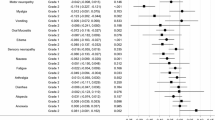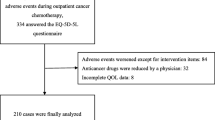Abstract
Background
Chemotherapy offers cancer patients the potential benefits of improved mortality and morbidity but may cause detrimental outcomes due to adverse drug events (ADEs), some of which requiring time-consuming, resource-intensive and costly clinical management. To appropriately assess chemotherapy agents in an economic evaluation, ADE-related parameters such as the incidence, (dis)utility and cost of ADEs should be reflected within the model parameters. To date, there has been no systematic summary of the existing literature that quantifies the utilities of ADEs due to healthcare interventions in general and chemotherapy treatments in particular.
Objective
This review aimed to summarize the current evidence base of reported utility values for chemotherapy-related ADEs.
Methods
A structured electronic search combining terms for utility, utility valuation methods and generic terms for cancer treatment was conducted in MEDLINE and EMBASE in June 2011. Inclusion criteria were: (1) elicitation of utility values for chemotherapy-related ADEs and (2) primary data. Two reviewers identified studies and extracted data independently. Any disagreements were resolved by a third reviewer.
Results
Eighteen studies met the inclusion criteria from the 853 abstracts initially identified, collectively reporting 218 utility values for chemotherapy-related ADEs. All 18 studies used short descriptions (vignettes) to obtain the utility values, with nine studies presenting the vignettes used in the valuation exercises. Of the 218 utility values, 178 were elicited using standard gamble (SG) or time trade-off (TTO) approaches, while 40 were elicited using visual analogue scales (VAS). There were 169 utility values of specific chemotherapy-related ADEs (with the top ten being anaemia [34 values], nausea and/or vomiting [32 values], neuropathy [21 values], neutropenia [12 values], diarrhoea [12 values], stomatitis [10 values], fatigue [8 values], alopecia [7 values], hand-foot syndrome [5 values] and skin reaction [5 values]) and 49 of non-specific chemotherapy-related adverse events. In most cases, it was difficult to directly compare the utility values as various definitions and study-specific vignettes were used for the ADEs of interest.
Limitations
This review was designed to provide an overall description of existing literature reporting utility values for chemotherapy-related ADEs. The findings were not exhaustive and were limited to publications that could be identified using the search strategy employed and those reported in the English language.
Conclusions
This review identified wide ranges in the utility values reported for broad categories of specific chemotherapy-related ADEs. There were difficulties in comparing the values directly as various study-specific definitions were used for these ADEs and most studies did not make the vignettes used in the valuation exercises available. It is recommended that a basic minimum requirement be developed for the transparent reporting of study designs eliciting utility values, incorporating key criteria such as reporting how the vignettes were developed and presenting the vignettes used in the valuation tasks as well as valuing and reporting the utility values of the ADE-free base states. It is also recommended, in the future, for studies valuing the utilities of chemotherapy-related ADEs to define the ADEs according to the National Cancer Institute (NCI) definitions for chemotherapy-related ADEs as the use of the same definition across studies would ease the comparison and selection of utility values and make the overall inclusion of adverse events within economic models of chemotherapy agents much more straightforward.
Similar content being viewed by others
References
Chanan-Khan AAA. Immunomodulating drugs for the treatment of cancer. Baltimore: Lippincott Williams & Wilkins; 2011.
Riedl MA, Casillas AM. Adverse drug reactions: types and treatment options. Am Fam Phys. 2003;68(9):1781–90.
National Cancer Institute. NCI Thesaurus Adverse Event (Code C41331). Bethesda: NCI; 2011. http://nciterms.nci.nih.gov/ncitbrowser/pages/concept_details.jsf?dictionary=NCI%20Thesaurus&code=C41331&type=properties. Accessed 7 Apr 2011.
National Cancer Institute. Common Terminology Criteria for Adverse Events and Common Toxicity Criteria. Version 4.0. Bethesda: NCI; 2010. http://ctep.cancer.gov/protocolDevelopment/electronic_applications/ctc.htm#ctc_40. Accessed 29 Nov 2011.
Martin M, Lluch A, Segui MA, Ruiz A, Ramos M, Adrover E, et al. Toxicity and health-related quality of life in breast cancer patients receiving adjuvant docetaxel, doxorubicin, cyclophosphamide (TAC) or 5-fluorouracil, doxorubicin and cyclophosphamide (FAC): impact of adding primary prophylactic granulocyte-colony stimulating factor to the TAC regimen. Ann Oncol. 2006;17(8):1205–12.
O’Brien MER, Borthwick A, Rigg A, Leary A, Assersohn L, Last K, et al. Mortality within 30 days of chemotherapy: a clinical governance benchmarking issue for oncology patients. Brit J Cancer. 2006;95(12):1632–6.
Lucarelli C, Nicholson S. A quality-adjusted price index for colorectal cancer drugs [NBER Working Paper 15174]. Cambridge: National Bureau of Economic Research; 2009. http://www.nber.org/papers/w15174.pdf. Accessed 18 Feb 2013.
Tosh JC, Longworth LJ, George E. Utility values in National Institute for Health and Clinical Excellence (NICE) Technology Appraisals. Value Health. 2011;14(1):102–9.
Craig D, McDaid C, Fonseca T, Stock C, Duffy S, Woolacott N. Are adverse effects incorporated in economic models? An initial review of current practice. Health Technol Assess 2009;13(62):1–171, 7–181, iii.
National Institute for Health and Clinical Excellence. Guide to the methods of technology appraisal. London: NICE; 2008. http://www.nice.org.uk/media/B52/A7/TAMethodsGuideUpdatedJune2008.pdf. Accessed 18 Feb 2013.
Green C, Brazier J, Deverill M. Valuing health-related quality of life: a review of health state valuation techniques. Pharmacoeconomics. 2000;17(2):151–65.
Loke YK, Price D, Herxheimer A. Adverse effects. In: Higgins JPT, Green S, editors. Cochrane handbook for systematic reviews of interventions version 5.0.2 (updated September 2009). Oxford: The Cochrane Collaboration; 2009.
Best JH, Garrison LP, Hollingworth W, Ramsey SD, Veenstra DL. Preference values associated with stage III colon cancer and adjuvant chemotherapy. Qual Life Res. 2010;19:391–400.
Beusterien KM, Szabo SM, Kotapati S, Mukherjee J, Hoos A, Hersey P, et al. Societal preference values for advanced melanoma health states in the United Kingdom and Australia. Brit J Cancer. 2009;101(3):387–9.
Beusterien KM, Davies J, Leach M, Meiklejohn D, Grinspan JL, O’Toole A, et al. Population preference values for treatment outcomes in chronic lymphocytic leukaemia: a cross-sectional utility study. Health Qual Life Outcomes. 2010;8(50). http://www.hqlo.com/content/8/1/50
Brown RE, Hutton J, Burrell A. Cost effectiveness of treatment options in advanced breast cancer in the UK. Pharmacoeconomics. 2001;19(11):1091–102.
Franic DM, Pathak DS, Gafni A. Are health states ‘timeless’? A case study of an acute condition: post-chemotherapy nausea and vomiting. J Eval Clin Pract. 2003;9(1):69–82.
Grunberg SM, Srivastava A, Grunberg KJ, Weeks J. Intensity of chemotherapy-induced emesis and overall survival as determinants of a global utility score. Support Care Cancer. 2002;10(8):624–9.
Grunberg SM, Weeks J, Magnan WF, Herndon J, Naughton ML, Blackwell KL, et al. Determination of utility scores for control of chemotherapy-induced nausea or vomiting—CALGB 309801. J Support Oncol. 2009;7(5):W17–22.
Havrilesky LJ, Broadwater G, Davis DM, Nolte KC, Barnett JC, Myers ER, et al. Determination of quality of life-related utilities for health states relevant to ovarian cancer diagnosis and treatment. Gynecol Oncol. 2009;113(2):216–20.
Hess LM, Malone DC, Reed PG, Skrepnek G, Weihs K. Preferences of patients and oncologists for advanced ovarian cancer treatment-related health states. Health Outcomes Res Med. 2010;1(1):51–9.
Hutton J, Brown R, Borowitz M, Abrams K, Rothman M, Shakespeare A. A new decision model for cost-utility comparisons of chemotherapy in recurrent metastatic breast cancer. Pharmacoeconomics. 1996;9(Suppl. 2):8–22.
Leung PP, Tannock IF, Oza AM, Puodziunas A, Dranitsaris G. Cost-utility analysis of chemotherapy using paclitaxel, docetaxel, or vinorelbine for patients with anthracycline-resistant breast cancer. J Clin Oncol. 1999;17(10):3082–90.
Lloyd A, Nafees B, Narewska J, Dewilde S, Watkins J. Health state utilities for metastatic breast cancer. Brit J Cancer. 2006;95(6):683–90.
Lloyd A, De Van Hanswijck JP, Doyle S, Cornes P. Health state utility scores for cancer-related anemia through societal and patient valuations. Value Health. 2008;11(7):1178–85.
Nafees B, Stafford M, Gavriel S, Bhalla S, Watkins J. Health state utilities for non small cell lung cancer. Health Qual Life Outcomes. 2008;6(84). http://www.hqlo.com/content/6/1/84
Ness RM, Holmes AM, Klein R, Dittus R. Utility valuations for outcome states of colorectal cancer. Am J Gastroenterol. 1999;94(6):1650–7.
Nguyen CT, Fu AZ, Gilligan TD, Wells BJ, Klein EA, Kattan MW, et al. Defining the optimal treatment for clinical stage I nonseminomatous germ cell testicular cancer using decision analysis. J Clin Oncol. 2010;28(1):119–25.
Ossa DF, Briggs A, McIntosh E, Cowell W, Littlewood T, Sculpher M. Recombinant erythropoietin for chemotherapy-related anaemia: economic value and health-related quality-of-life assessment using direct utility elicitation and discrete choice experiment methods. Pharmacoeconomics. 2007;25(3):223–37.
Shiroiwa T, Fukuda T, Tsutani K. Health utility scores of colorectal cancer based on societal preference in Japan. Qual Life Res. 2009;18(8):1095–103.
Peasgood T, Herrmann K, Kanis JA, Brazier JE. An updated systematic review of health state utility values for osteoporosis related conditions. Osteoporos Int. 2009;20(6):853–68.
Tengs TO, Wallace A. One thousand health-related quality-of-life estimates. Med Care. 2000;38(6):583–637.
Ara R, Wailoo A, Decision Support Unit. The use of health state utility values in decision models [NICE technical support document 12]. London: NICE; 2011. http://www.nicedsu.org.uk/TSD12%20Utilities%20in%20modelling%20FINAL.pdf. Accessed 18 Feb 2013.
International Society for Pharmacoeconomics and Outcomes Research. Pharmacoeconomic guidelines around the world. Lawrenceville: ISPOR; 2012. http://www.ispor.org/PEguidelines/index.asp. Accessed 12 Apr 2012.
Prosser LA, Grosse SD, Wittenberg E. Health utility elicitation: is there still a role for direct methods? Pharmacoeconomics. 2012;30(2):83–6.
Brazier J, Rowen D, Decision Support Unit. Alternatives to EQ-5D for generating health state utility values [NICE technical support document 11]. London: NICE; 2011. http://www.nicedsu.org.uk/TSD11%20Alternatives%20to%20EQ-5D_final.pdf. Accessed 18 Feb 2013.
Wright DR, Wittenberg E, Swan JS, Miksad RA, Prosser LA. Methods for measuring temporary health states for cost-utility analyses. Pharmacoeconomics. 2009;27(9):713–23.
Fu AZ, Kattan MW. Utilities should not be multiplied: evidence from the preference-based scores in the United States. Med Care. 2008;46(9):984–90.
Drummond M, Jefferson TO. Guidelines for authors and peer reviewers of economic submissions to the BMJ. Brit Med J. 1996;313:275–83.
Acknowledgements
KP is part funded by a Research Council UK (RCUK) Academic Fellowship. FHS, LC and RAE did not receive any external funding to complete this work. The authors have no conflicts of interest to declare.
Authors’ Contributions
The authors are responsible for the reported research, and have participated in the conceptualization of the study and interpretation of the data. FHS, LC and KP conducted data collection and analysis. All the authors participated in drafting the manuscript, and have approved the final manuscript for submission. FHS generated the research protocol, conducted the literature search, reviewed and extracted data, analysed study results and prepared the manuscript. LC assisted with the literature review and data extraction. RAE provided advice on the overall study. KP provided advice on the overall study, assisted with data extraction and was involved with the preparation of the manuscript. KP acts as the overall guarantor for the content of this article.
Author information
Authors and Affiliations
Corresponding author
Electronic supplementary material
Below is the link to the electronic supplementary material.
Rights and permissions
About this article
Cite this article
Shabaruddin, F.H., Chen, LC., Elliott, R.A. et al. A Systematic Review of Utility Values for Chemotherapy-Related Adverse Events. PharmacoEconomics 31, 277–288 (2013). https://doi.org/10.1007/s40273-013-0033-x
Published:
Issue Date:
DOI: https://doi.org/10.1007/s40273-013-0033-x




